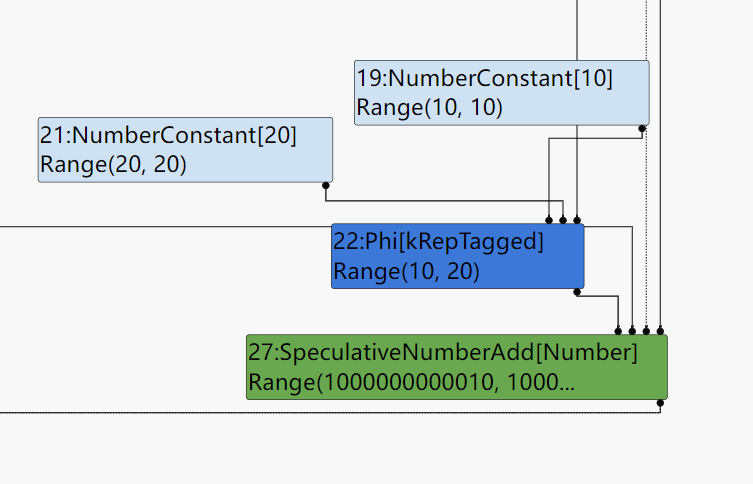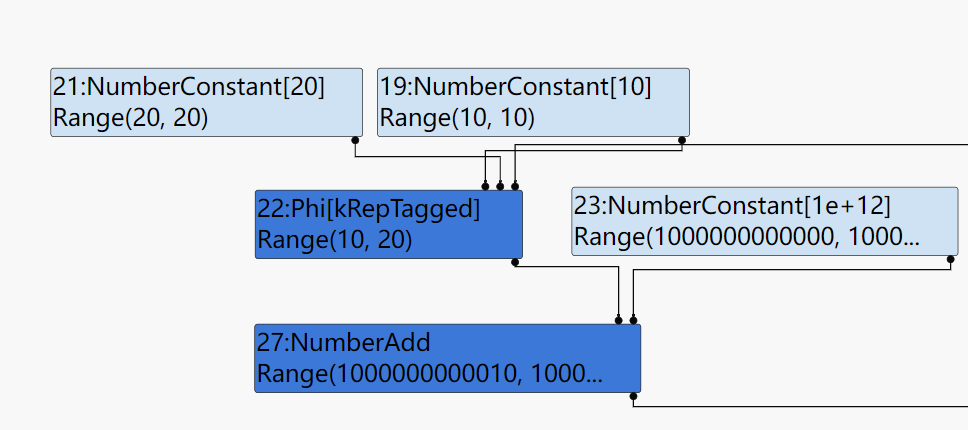about the sea of node
google document about turbofan and SoN
v8的优化过程都是基于sea of node这种IR进行的,所以在学习v8的优化过程之前需要先对sea of node有一些了解。
通过cliff click 1993年的一篇论文和网上的一些资料可以对SoN有一定的了解,当然对于SoN在优化时的具体操作方法,以及在优化结束之后如何由sea of node重新构建CFG这些还不太清楚。
V8将byte code转换为图形式的sea of node并在sea of node上进行优化。sea of node是一种图形式的IR它有下面的特点:
- sea of node没有BB这种结构,指令作为图中的node,整个方法中的node构成一张大图。这样基于sea of node的优化都是全局的。
- sea of node是SSA形式的,且数据依赖被直接保存在指令中,和llvm IR很相似,可以直接访问use-def链且use-def链非常简单。
- 在sea of node中除了被控制流链接起来的控制结点(start,region,IF)这些结点的是固定的,其他的指令因为缺少了基本块的束缚都是浮动的,可以在全局内进行移动。但是这些结点的移动也不是任意进行的,这些副作用结点之间有自己的依赖关系(先读后写,如果被调度为先写后读,那么读出的内容就会发生变化),只有在依赖满足时才可以执行副作用指令。

上面的图中是线性IR和SoN之间的转换关系,一个sea of node转化为线性IR可以很多种情况,这也表明sea of node中的结点有很高的可调度性。
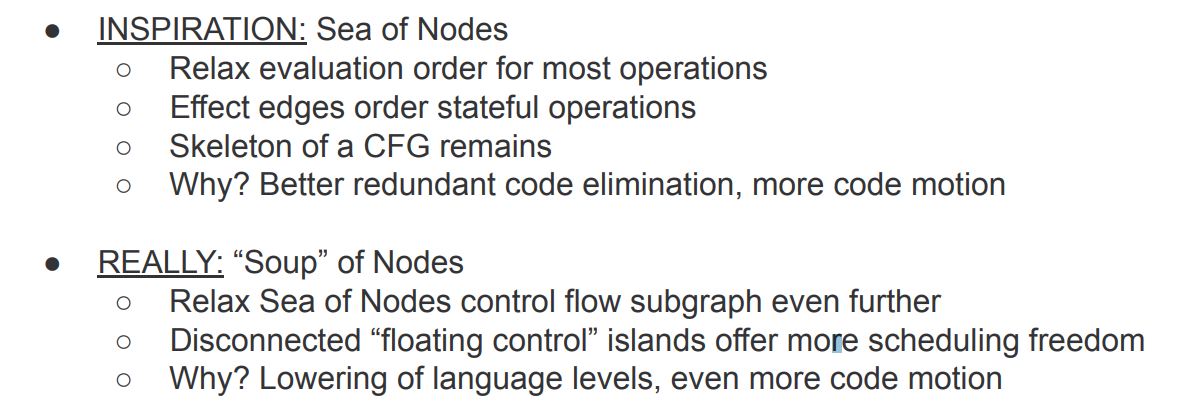
实际上正是因为sea of node中结点组织关系的松散(在llvm IR中进行transformation时要不断的在BB中删除插入指令)在基于sea of node进行大部分优化时只需要进行边的连接和删除,这样可以大量的节省优化所需的时间。且因为sea of node松散的组织结构,优化器可以通过schedule这些node的位置来获得最好的优化效果(减小寄存器调度的压力,配合CPU流水线),并且在sea of node中schedule的过程相对于线性IR要简单很多。
之后来看看在不同阶段turbofan对于sea of node的优化过程。
turbofan optimization
V8 version: 7.0.276.3
使用下面这个JS代码片段作为例子,通过观察turbofan对于这段代码片段的优化过程学习turbofan的优化流程。
1
2
3
4
5
function opt_me() {
let x = Math.random();
let y = x + 2;
return y + 3;
}
在turbofan的优化过程中首先会将字节码转换为sea of node,v8开发团队提供了名为turbolizer的工具可以查看sea of node在turbofan优化各个阶段的状态。使用turbolizer有两个步骤:
- 首先构建turbolizer,turbolizer使用下面的命令构建:
1
2
3
4
5
#tools/turbolizer/
cd tools/turbolizer
npm i
npm run-script build
python -m SimpleHTTPServer
然后用浏览器访问对应的端口就可以进入turbolizer的界面。
- 另外在使用turbolizer的时候需要由v8生成的.cfg和.json文件。需要在d8执行JS代码时加上–trace-turbo这个参数,在代码执行结束后就会生成这两个文件。将这两个文件加载到turbolizer中就可以观察在不同优化通道中sea of node的图形视图。
按不同优化通道的优化顺序来观察turbofan对上面opt_me()函数的优化,首先是Graph build阶段,这个阶段负责生成未优化的sea of node,下面是从turbolizer中截取的有关函数逻辑的生成图:
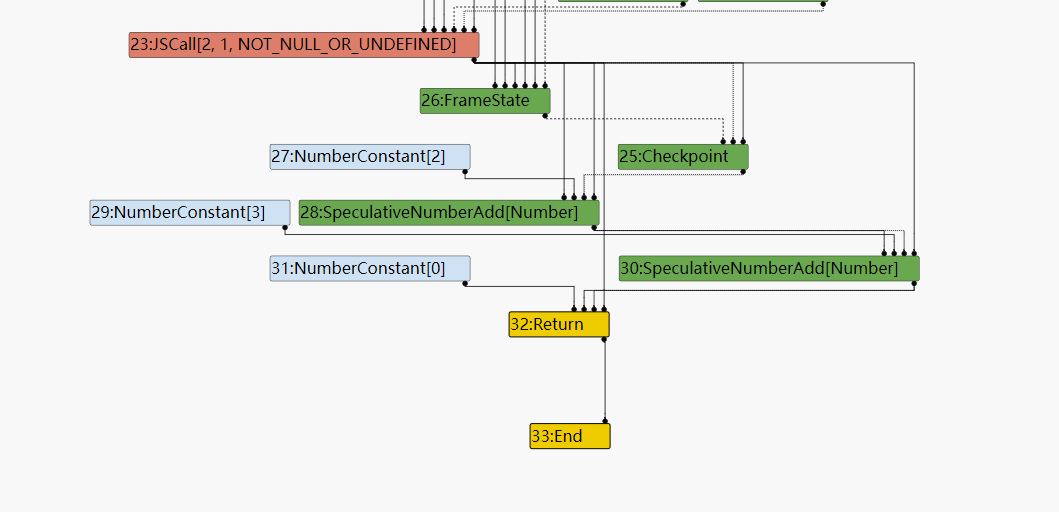
- 一次JSCall代表了对
Math.random()这个函数的调用。 - 两次SpeculativeNumberAdd代表了两次加法运算。
下面就要正式进入turbofan的优化阶段。
Typer phase
source code analysis
在SoN构造完成之后会对SoN进行Typer phase。Typer phase也是turbofan推测优化的一部分它负责为每个结点赋予可能的Type, Typer直接从node类型综合操作数等其他信息,推断出预期的Type。有了Type就可以针对特定的Type对SoN进一步优化。
Typer phase由createGraph()调用,在SoN构造完成之后负责为图中的每个结点关联上预测的类型。
1
2
3
4
5
6
7
//pipeline.cc
// Type the graph and keep the Typer running on newly created nodes within
// this scope; the Typer is automatically unlinked from the Graph once we
// leave this scope below.
Typer typer(isolate(), data->js_heap_broker(), flags, data->graph());
Run<TyperPhase>(&typer);
RunPrintAndVerify(TyperPhase::phase_name());
Run<TyperPhase>(&typer)会调用TyperPhase类的Run()函数,然后再由TyperPhase的Run()函数最终调用Typer的Run()函数。在Typer的Run()函数中使用Typer对象初始化一个Visitor,并用这个访问者去遍历所有的Node。visitor的Reduce()函数负责对每个Node进行Typer reduce。
1
2
3
4
5
6
7
8
9
10
11
12
13
14
15
16
//typer.cc
void Typer::Run(const NodeVector& roots,
LoopVariableOptimizer* induction_vars) {
if (induction_vars != nullptr) {
induction_vars->ChangeToInductionVariablePhis();
}
Visitor visitor(this, induction_vars);//创建一个visitor
GraphReducer graph_reducer(zone(), graph());
graph_reducer.AddReducer(&visitor);//在Reducer vector中添加Typer Reducer
for (Node* const root : roots) graph_reducer.ReduceNode(root);//遍历start?
graph_reducer.ReduceGraph();//使用Reducer vector中的Reducer遍历图中的所有结点进行Reduce操作
if (induction_vars != nullptr) {
induction_vars->ChangeToPhisAndInsertGuards();
}
}
在Typer的Visitor的Reducer()函数中使用一个大的Switch case结构来根据node的opcode将当前正在遍历的node分发到对应的Typer函数去处理:
1
2
3
4
5
6
7
8
9
10
11
12
13
14
15
16
17
18
19
20
21
22
23
24
25
26
27
28
29
//typer.cc
Reduction Reduce(Node* node) override {
if (node->op()->ValueOutputCount() == 0) return NoChange();
//dispatch the node!
switch (node->opcode()) {
#define DECLARE_CASE(x) \
case IrOpcode::k##x: \
return UpdateType(node, TypeBinaryOp(node, x##Typer));
JS_SIMPLE_BINOP_LIST(DECLARE_CASE)
#undef DECLARE_CASE
#define DECLARE_CASE(x) \
case IrOpcode::k##x: \
return UpdateType(node, Type##x(node));
DECLARE_CASE(Start)
DECLARE_CASE(IfException)
// VALUE_OP_LIST without JS_SIMPLE_BINOP_LIST:
COMMON_OP_LIST(DECLARE_CASE)
SIMPLIFIED_COMPARE_BINOP_LIST(DECLARE_CASE)
……
#undef DECLARE_CASE
#define DECLARE_CASE(x) \
case IrOpcode::k##x: \
return UpdateType(node, TypeBinaryOp(node, x));
SIMPLIFIED_NUMBER_BINOP_LIST(DECLARE_CASE)
SIMPLIFIED_SPECULATIVE_NUMBER_BINOP_LIST(DECLARE_CASE)
#undef DECLARE_CASE
……
根据node的opcode的类型将调用对应的Typer函数:如果node的opcode类型为JSCall(根据上面的例子)那么调用的Typer函数就是JSCallTyper()。之后进入JSCallTyper()这个函数中看一下:
1
2
3
4
5
6
7
8
9
10
11
12
13
Type Typer::Visitor::JSCallTyper(Type fun, Typer* t) {
if (!fun.IsHeapConstant() || !fun.AsHeapConstant()->Ref().IsJSFunction()) {
return Type::NonInternal();
}
JSFunctionRef function = fun.AsHeapConstant()->Ref().AsJSFunction();
if (!function.shared().HasBuiltinFunctionId()) {
return Type::NonInternal();
}
switch (function.shared().builtin_function_id()) {
case BuiltinFunctionId::kMathRandom:
return Type::PlainNumber();
case BuiltinFunctionId::kMathFloor:
……
从上面的源码中可以看到,JSCallTyper()这个函数首先判断由JSCall调用的函数是否为内置函数,如果是内置函数的,就可以将JSCall与所调用内置函数的预期返回值类型关联起来。在上面的opt_me()函数中调用了 Math.random()这个builtin函数,Typer预期这个内置函数返回值类型是PlainNumber,所以在Typer结束后这个JSCall node将被打上PlainNumber的标签。
之后Typer会对NumberConstant这个结点进行处理。处理过程在TypeNumberConstant()这个函数中:
1
2
3
4
5
6
7
8
9
10
11
12
13
14
15
16
17
18
Type Typer::Visitor::TypeNumberConstant(Node* node) {
double number = OpParameter<double>(node->op());
return Type::NewConstant(number, zone());
}
Type Type::NewConstant(double value, Zone* zone) {
if (RangeType::IsInteger(value)) {
return Range(value, value, zone);
} else if (IsMinusZero(value)) {
return Type::MinusZero();
} else if (std::isnan(value)) {
return Type::NaN();
}
DCHECK(OtherNumberConstantType::IsOtherNumberConstant(value));
return OtherNumberConstant(value, zone);
}
在TypeNumberConstant()中首先取出node所代表的常量值value,之后传入NewConstant这个函数中。在NewConstant中负责根据value的值来返回对应的Type:
- 如果value的值为整形,那么返回一个range类型,range类型的是带有范围的整形。
- 如果value的值为-0,返回MinusZero类型。
- 如果是NaN,还返回NaN类型。
- 以上都不成立的话那value应该是一个浮点型的值,所以返回OtherNumberConstant Type。
然后Typer将处理SpeculativeNumberAdd类型的结点。在Typer的visitor的Reduce()中被调用的是,TypeBinaryOp()这个函数:
1
2
3
4
5
6
#define DECLARE_CASE(x) \
case IrOpcode::k##x: \
return UpdateType(node, TypeUnaryOp(node, x));
SIMPLIFIED_NUMBER_UNOP_LIST(DECLARE_CASE)
SIMPLIFIED_SPECULATIVE_NUMBER_UNOP_LIST(DECLARE_CASE)
#undef DECLARE_CASE
在TypeBinaryOp()中会将二元指令的两个操作数的Type都取出来,然后调用SpeculativeNumberAdd()。
1
2
3
4
5
6
Type Typer::Visitor::TypeBinaryOp(Node* node, BinaryTyperFun f) {
Type left = Operand(node, 0);//取第一个操作数的Type
Type right = Operand(node, 1);//取第二个操作数的Type
return left.IsNone() || right.IsNone() ? Type::None()
: f(left, right, typer_);
}
在SpeculativeNumberAdd()先尝试将两个操作数的Type转换为Number,Number包括所有smi、double、uint32、-0.0、NaN。因为SpeculativeNumberAdd左右两个操作数一个是Range属于Number(NumberConstant结点),另一个是PlainNumber(JSCall结点)也属于Number所以直接返回原Type。,保存在lhs和rhs里。
1
2
3
4
5
6
7
#define SPECULATIVE_NUMBER_BINOP(Name) \
Type OperationTyper::Speculative##Name(Type lhs, Type rhs) { \
lhs = SpeculativeToNumber(lhs); \
rhs = SpeculativeToNumber(rhs); \
return Name(lhs, rhs); \
}
SPECULATIVE_NUMBER_BINOP(NumberAdd)
最后用lhs和rhs中返回的Type调用NumberAdd()计算结点SpeculativeNumberAdd的Type,在NumberAdd()中检查一些极端情况比如说操作数Type是不是MinusZero,NaN……根据之前的操作数Type,在左右操作数都属于PlanNumber的情况下,最终返回的Type还是PlainNumber。
1
2
3
4
5
6
7
8
9
10
11
12
13
14
15
16
17
18
19
Type type = Type::None();
lhs = Type::Intersect(lhs, Type::PlainNumber(), zone());
rhs = Type::Intersect(rhs, Type::PlainNumber(), zone());
if (!lhs.IsNone() && !rhs.IsNone()) {
if (lhs.Is(cache_.kInteger) && rhs.Is(cache_.kInteger)) {
type = AddRanger(lhs.Min(), lhs.Max(), rhs.Min(), rhs.Max());
} else {
if ((lhs.Maybe(minus_infinity_) && rhs.Maybe(infinity_)) ||
(rhs.Maybe(minus_infinity_) && lhs.Maybe(infinity_))) {
maybe_nan = true;
}
type = Type::PlainNumber();
}
}
// Take into account the -0 and NaN information computed earlier.
if (maybe_minuszero) type = Type::Union(type, Type::MinusZero(), zone());
if (maybe_nan) type = Type::Union(type, Type::NaN(), zone());
return type;
在数字有关的Type关系如下,上面的Type推导都是根据下面Type之间的关系进行的:
1
2
3
4
V(PlainNumber, kIntegral32 | kOtherNumber) \
V(OrderedNumber, kPlainNumber | kMinusZero) \
V(MinusZeroOrNaN, kMinusZero | kNaN) \
V(Number, kOrderedNumber | kNaN) \
到现在为止整个Typer过程已经完成。
如下是经历了typer之后sea of node的图形化表示:
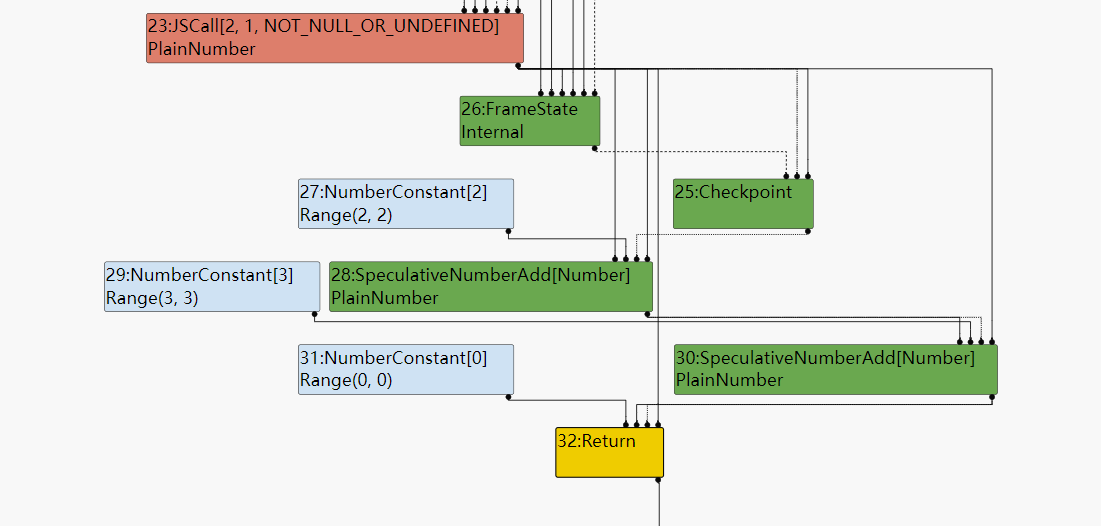
Typed lowering
经过Typer phase之后很多结点已经被打上Type,相当于一个动态类型语言(类型无法确定)到现在已经拥有了推测的类型,虽然类型可能并不精确,但是仍然是一个很大的进步。这些类型信息可以用于简化结点对应的操作,拿Add操作举例子:如果没有类型信息,add可以是number,string,object的加法,但是一旦有了推测的add类型,那么最终生成的机器码将专注于这一种类型这将删掉很多冗余操作。
所以在Typer phase之后关注的优化是Typed lowering,这个phase将根据结点的Type信息对node进一步简化。还是在createGraph()这个函数中在Run<TyperPhase>(&typer);之后将调用Typed Lowering:
1
2
3
4
//pipeline.cc CreateGraph()
// Lower JSOperators where we can determine types.
Run<TypedLoweringPhase>();
RunPrintAndVerify(TypedLoweringPhase::phase_name());
和Typer phase一样外层的Run()最终会调用TypedLoweringPhase的Run()。
1
2
3
4
5
6
7
8
9
10
11
12
13
14
//pipeline.cc
void Run(PipelineData* data, Zone* temp_zone) {
……
AddReducer(data, &graph_reducer, &dead_code_elimination);
AddReducer(data, &graph_reducer, &duplicate_addition_reducer);
AddReducer(data, &graph_reducer, &create_lowering);
AddReducer(data, &graph_reducer, &constant_folding_reducer);
AddReducer(data, &graph_reducer, &typed_optimization);
AddReducer(data, &graph_reducer, &typed_lowering);
AddReducer(data, &graph_reducer, &simple_reducer);
AddReducer(data, &graph_reducer, &checkpoint_elimination);
AddReducer(data, &graph_reducer, &common_reducer);
graph_reducer.ReduceGraph();
}
在TypedLoweringPhase的Run()中向Reducer Vector中添加了很多reducer。其中我比较关注的是Typed Opimization和Typed Lowering这两个redcuer。
Typed Optimization:对SoN中的一些非JSNode进行优化,这个可能包括对一些CheckNode(CheckNode、CheckString……)的消除还有对一些Node(phi)的Type的化简。
ReduceGraph()将调用TypedOptimization的Reduce()函数遍历整张图,在Redcue()函数中有一个很大的swicth case根据node的opcode来分发node到对应的优化函数。1 2 3 4 5 6 7 8 9 10 11 12 13 14
//typed-optimization.cc TypedOptimization::Reduce() case IrOpcode::kCheckNumber: return ReduceCheckNumber(node); case IrOpcode::kCheckString: return ReduceCheckString(node); case IrOpcode::kCheckEqualsInternalizedString: return ReduceCheckEqualsInternalizedString(node); …… case IrOpcode::kNumberFloor: return ReduceNumberFloor(node); case IrOpcode::kNumberToUint8Clamped: return ReduceNumberToUint8Clamped(node); case IrOpcode::kPhi: return ReducePhi(node);
对于Typed Lowering来说
ReduceGraph()将调用JSTypedLowering这个类的Reduce()函数。而在v8的注释中也很清楚的解释了JSTYpedLowering这个类的作用:1
// Lowers JS-level operators to simplified operators based on types.
这个类主要是对JS-level的node进行化简。在它的Reduce函数中也有一个很大的switch case结构,负责根据node的opcode将node分发到对应的优化函数中。
1 2 3 4 5 6 7 8 9 10 11 12 13
Reduction JSTypedLowering::Reduce(Node* node) { DisallowHeapAccess no_heap_access; switch (node->opcode()) { case IrOpcode::kJSEqual: return ReduceJSEqual(node); case IrOpcode::kJSStrictEqual: return ReduceJSStrictEqual(node); case IrOpcode::kJSLessThan: // fall through case IrOpcode::kJSGreaterThan: // fall through case IrOpcode::kJSLessThanOrEqual: // fall through case IrOpcode::kJSGreaterThanOrEqual: return ReduceJSComparison(node);
SpeculativeNumberAdd Typed Lowering
之后具体的来看一下在Typed Lowering这个阶段是如何对SpeculativeNumberAdd()这个node进行优化的。这个node属于JS-level的node,所以它应该在JSTypedLowering的Reduce()中被优化.
1
2
case IrOpcode::kSpeculativeNumberAdd:
return ReduceSpeculativeNumberAdd(node);
Reduce()调用ReduceSpeculativeNumberAdd()。
1
2
3
4
5
6
7
8
9
10
11
12
13
14
Reduction JSTypedLowering::ReduceSpeculativeNumberAdd(Node* node) {
JSBinopReduction r(this, node);
NumberOperationHint hint = NumberOperationHintOf(node->op());
if ((hint == NumberOperationHint::kNumber ||
hint == NumberOperationHint::kNumberOrOddball) &&
r.BothInputsAre(Type::PlainPrimitive()) &&
r.NeitherInputCanBe(Type::StringOrReceiver())) {
// SpeculativeNumberAdd(x:-string, y:-string) =>
// NumberAdd(ToNumber(x), ToNumber(y))
r.ConvertInputsToNumber();
return r.ChangeToPureOperator(simplified()->NumberAdd(), Type::Number());
}
return NoChange();
}
首先从判断node的hint是什么:因为在SoN中的两个SpeculativeNumberAdd都是PlainNumber类型,所以得到的hint是Number。
然后判断两个操作数是否是PlainPrimitive类型:PlainPrimitive包括Number,String,Boolean,而所有的SpeculativeNumberAdd的操作数都属于Number,所以这个判断为真。
1 2
V(PlainPrimitive, kNumber | kString | kBoolean | \ kNullOrUndefined) \
在前面的条件都满足的情况下,调用convertInputsToNumber()先将操作数都转换为Number类型,这个函数将其他类型的PlainPrimitive类型的Node转换为Number类型的Node,其中可能向SoN中替换Node或者插入ToNumber的Node。
最后用一个NumberAdd的Node替换SpeculativeNumberAdd。
经过Typed Lowering和Constant Folding之后的SoN:
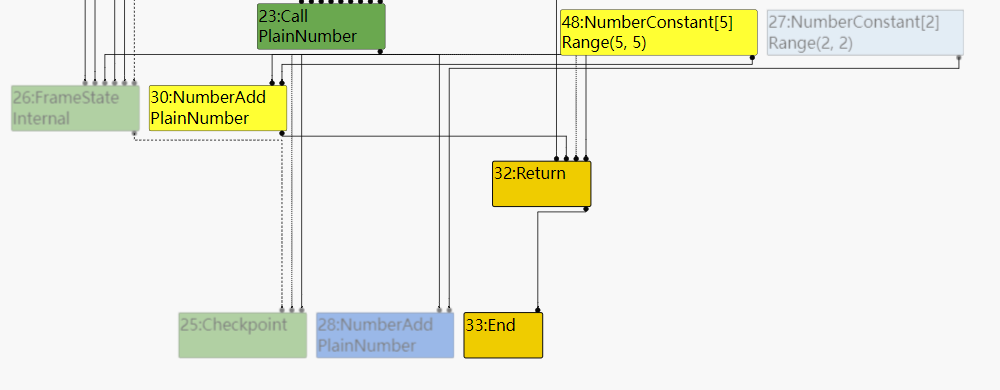
SpeculativeNumberAdd已经被转化为NumberAdd且+2+3已经被折叠为+5。
JSCall Typed Lowering
然后是对JSCall的Typed Lowering。
1
2
3
4
5
6
7
8
9
10
11
12
//js-typed-lowering.cc
Reduction JSTypedLowering::ReduceJSCall(Node* node) {
DCHECK_EQ(IrOpcode::kJSCall, node->opcode());
CallParameters const& p = CallParametersOf(node->op());
int const arity = static_cast<int>(p.arity() - 2);
ConvertReceiverMode convert_mode = p.convert_mode();
Node* target = NodeProperties::GetValueInput(node, 0);
Type target_type = NodeProperties::GetType(target);
Node* receiver = NodeProperties::GetValueInput(node, 1);
Type receiver_type = NodeProperties::GetType(receiver);
Node* effect = NodeProperties::GetEffectInput(node);
Node* control = NodeProperties::GetControlInput(node);
先从node中取出data dependency,control information, effect dependency。从这个取出的过程可以了解到JSCall这个opcode的第一个操作数是调用的目标函数,第二个操作数是调用过程的receive object。
1
2
3
4
5
6
7
8
9
10
11
12
13
14
15
16
17
18
19
20
21
22
23
24
25
26
27
28
29
30
31
32
33
34
35
36
37
38
39
40
41
42
43
44
45
46
47
//js-typed-lowering.cc
[……]
// Check if {target} is a known JSFunction.
if (target_type.IsHeapConstant() &&
target_type.AsHeapConstant()->Ref().IsJSFunction()) {
JSFunctionRef function = target_type.AsHeapConstant()->Ref().AsJSFunction();
SharedFunctionInfoRef shared = function.shared();
[……]
// Load the context from the {target}.
Node* context = effect = graph()->NewNode(
simplified()->LoadField(AccessBuilder::ForJSFunctionContext()), target,
effect, control);
NodeProperties::ReplaceContextInput(node, context);
[……]
// Update the effect dependency for the {node}.
NodeProperties::ReplaceEffectInput(node, effect);
// Compute flags for the call.
CallDescriptor::Flags flags = CallDescriptor::kNeedsFrameState;
Node* new_target = jsgraph()->UndefinedConstant();
Node* argument_count = jsgraph()->Constant(arity);
if (NeedsArgumentAdaptorFrame(shared, arity)) {
[……]
} else if (shared.HasBuiltinId() &&
Builtins::HasCppImplementation(shared.builtin_id())) {
// Patch {node} to a direct CEntry call.
ReduceBuiltin(jsgraph(), node, shared.builtin_id(), arity, flags);
} else if (shared.HasBuiltinId() &&
Builtins::KindOf(shared.builtin_id()) == Builtins::TFJ) {
// Patch {node} to a direct code object call.
Callable callable = Builtins::CallableFor(
isolate(), static_cast<Builtins::Name>(shared.builtin_id()));
CallDescriptor::Flags flags = CallDescriptor::kNeedsFrameState;
const CallInterfaceDescriptor& descriptor = callable.descriptor();
auto call_descriptor = Linkage::GetStubCallDescriptor(
graph()->zone(), descriptor, 1 + arity, flags);
Node* stub_code = jsgraph()->HeapConstant(callable.code());
node->InsertInput(graph()->zone(), 0, stub_code); // Code object.
node->InsertInput(graph()->zone(), 2, new_target);
node->InsertInput(graph()->zone(), 3, argument_count);
NodeProperties::ChangeOp(node, common()->Call(call_descriptor));
}
这里有一点不太懂就是注释里说的“is a known JSFunction”是什么意思,是指非用户定义函数么?
在例子中这个JSCall所调用的是Math.random()这个函数是一个由Code Stub Assembler所编写的内置函数。首先会为JSCall创建一个LoadField结点用于从JSFunction中获取函数调用的上下文。
然后判断当前调用的函数是否是由CSA内置函数,如果是的话就取出对应BuiltinID的内置函数,再从内置函数中取出可执行代码的地址stub_code,将stub_code作为JSCall的第一个参数(target)插入到node的input中。最后将node的opcode修改为Call。这样一个Math.random()的JSCall就优化完了。从JSCall到Call,这个过程降低了操作的复杂度。
下面是经过Typed Lowering之后这一次函数调用的图形化表示,可以看到第一个操作数已经被修改为Builtin function的code。
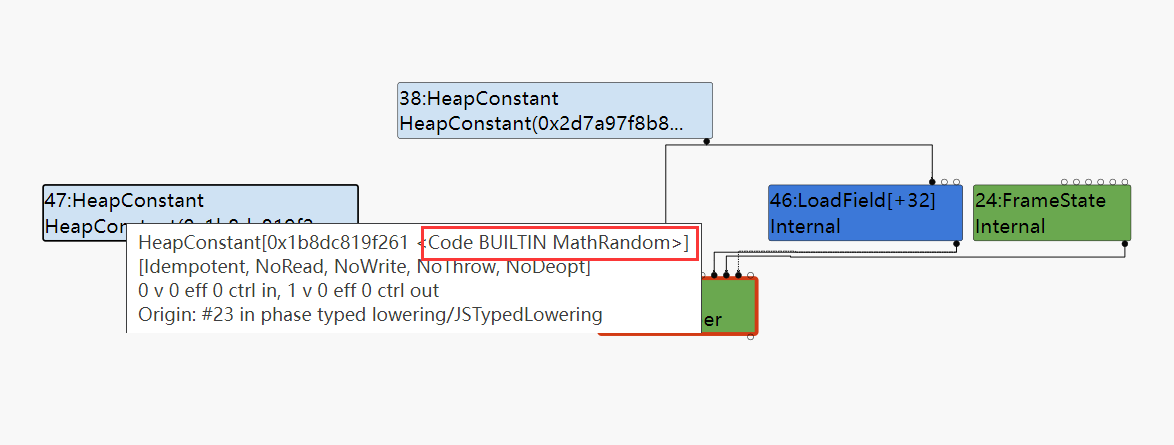
Range Type
在之前的分析中我们已经看到了许多次Range这个Type,但是看到的都是Range(n, n)这样的形式的Range。但是实际上Range可以有很多种形状,且在Turbofan中经常对代表算数运算的Node的Range Type进行合并,拿下面这段JS代码举个例子:
1
2
3
4
5
6
7
8
9
10
11
12
13
14
15
16
function opt_me(b) {
let x = 10; // [1] x0 = 10
if (b == "foo")
x = 5; // [2] x1 = 5
// [3] x2 = phi(x0, x1)
let y = x + 2;
y = y + 1000;
y = y * 2;
return y;
}
opt_me("foo");
%OptimizeFunctionOnNextCall(opt_me);
opt_me("foo");
先看以下在未进行优化之前的SoN长什么样子:
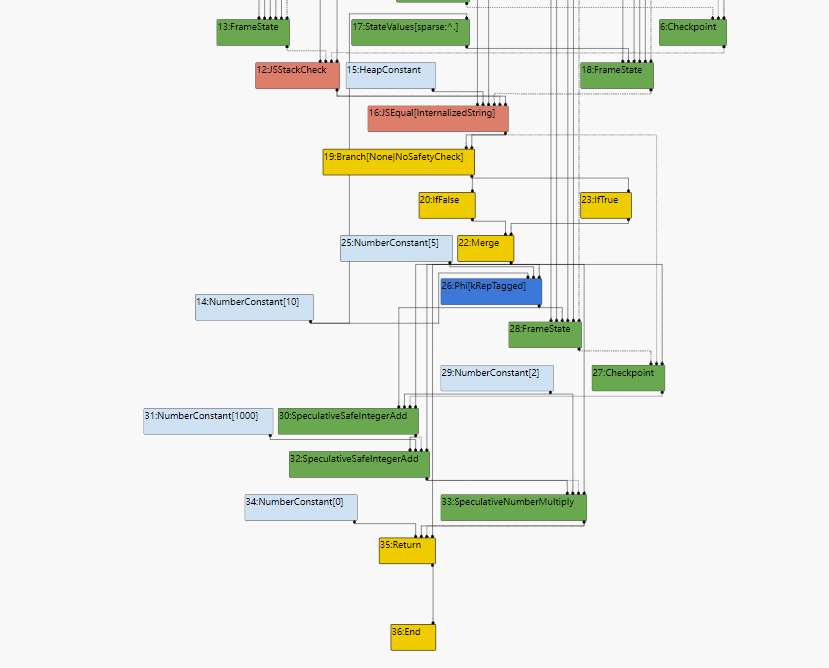
源码中的加法对应到SoN中是SpeculativeSafeIntegerAdd这样的Node,之所以产生这样的Node而不产生和之前一样SpeculativeNumberAdd的Node的原因是因为Speculative Optimization。
- 在优化前进行的那一次调用中传入的是一个smi,这样Ignition在收集feedback时,加法的Type feedback就被设置为smi。
- 之后opt_me被送入turbofan进行优化构建SoN时,turbofan就会参考feed back中的Type information生成SoN中的结点而smi对应的就是SpeculativeSafeIntegerAdd。
从打印出的feedback vector也可以看出这种情况:
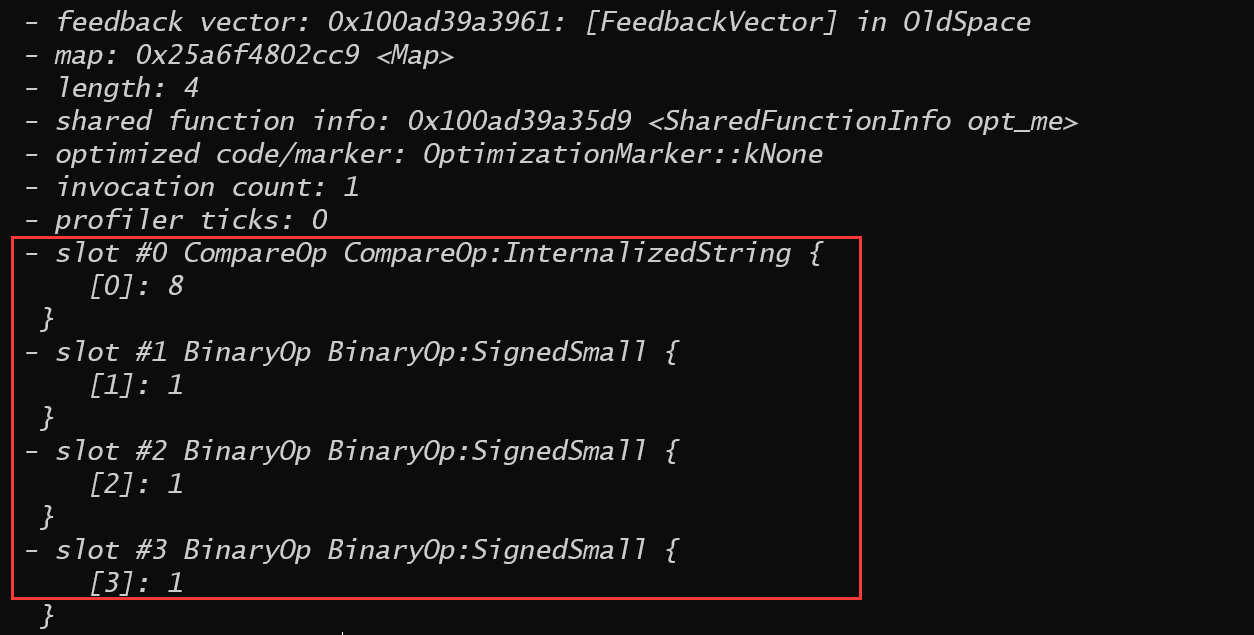
phi Node Typer
继续回到range,我们先来看一下SoN中的phi Node,这个phi Node用于merge两个x的值,当传入的字符串为”foo“时x3 = x2 = 5,否则x3 = x1 = 10。在SoN中x1和x2都表示为NumberConstant,所以x1的Type是Range(10,10),x2的Type是Range(5,5)。关注于phi的Type我们通过阅读代码来推导一下。
Typer的Reduce()将会调用TypePhi()这个函数对phi Node进行Typer。
1
2
3
4
5
6
7
8
9
Type Typer::Visitor::TypePhi(Node* node) {
int arity = node->op()->ValueInputCount();
Type type = Operand(node, 0);
for (int i = 1; i < arity; ++i) {
type = Type::Union(type, Operand(node, i), zone());
}
return type;
}
这个函数的逻辑就是将phi Node的所有输入的Type都Union起来得到的Type就是phi Node的Type。将Range(5,5)和Range(10,10)Union起来之后就是Range(5,10)。这样就完成了对于phi Node对于Range的计算,最终的Type就是Range(5,10)。
之后这个Type将继续沿着计算的路线向下传递,然后就是SpeculativeSafeIntegerAdd中对于Range的计算。
SpeculativeSafeIntegerAdd Typer
SpeculativeSafeIntegerAdd的Typer过程和上面的SpeculativeAdd的Typer过程很一样(因为都是推测结点)。先从左右操作数中获得Type,对于let y = x + 2;这条语句来说生成的Node的左右操作数的Type都是Range(Rang(5, 10),Range(2, 2)),然后进入经过SpeculativeToNumber()返回的还是原Type。最后进入NumberAdd()。
上面分析对SpeculativeNumberAdd()进行Typer的时候分析过这个函数,处理一些极端情况-0.0和NaN之后,当两个操作数的Type都是Range的时候会进入下面的分支:
1
2
3
4
5
6
7
8
9
10
11
12
13
14
Type type = Type::None();
lhs = Type::Intersect(lhs, Type::PlainNumber(), zone());
rhs = Type::Intersect(rhs, Type::PlainNumber(), zone());
if (!lhs.IsNone() && !rhs.IsNone()) {
if (lhs.Is(cache_.kInteger) && rhs.Is(cache_.kInteger)) {
type = AddRanger(lhs.Min(), lhs.Max(), rhs.Min(), rhs.Max());//get into this branch
} else {
if ((lhs.Maybe(minus_infinity_) && rhs.Maybe(infinity_)) ||
(rhs.Maybe(minus_infinity_) && lhs.Maybe(infinity_))) {
maybe_nan = true;
}
type = Type::PlainNumber();
}
}
AddRange()函数是计算两个携带Range的Node相加之后的Node的Range:
1
2
3
4
5
6
7
8
9
10
11
12
13
14
15
16
17
18
19
20
21
22
23
24
25
Type OperationTyper::AddRanger(double lhs_min, double lhs_max, double rhs_min,
double rhs_max) {
double results[4];
results[0] = lhs_min + rhs_min;
results[1] = lhs_min + rhs_max;
results[2] = lhs_max + rhs_min;
results[3] = lhs_max + rhs_max;
// Since none of the inputs can be -0, the result cannot be -0 either.
// However, it can be nan (the sum of two infinities of opposite sign).
// On the other hand, if none of the "results" above is nan, then the
// actual result cannot be nan either.
int nans = 0;
for (int i = 0; i < 4; ++i) {
if (std::isnan(results[i])) ++nans;
}
if (nans == 4) return Type::NaN();
Type type = Type::Range(array_min(results, 4), array_max(results, 4), zone());
if (nans > 0) type = Type::Union(type, Type::NaN(), zone());
// Examples:
// [-inf, -inf] + [+inf, +inf] = NaN
// [-inf, -inf] + [n, +inf] = [-inf, -inf] \/ NaN
// [-inf, +inf] + [n, +inf] = [-inf, +inf] \/ NaN
// [-inf, m] + [n, +inf] = [-inf, +inf] \/ NaN
return type;
}
计算的逻辑是用两个Range的四个边界(lhs_min,lhs_max,rhs_min,rhs_max)互相相加得到四个结果,取四个结果中最小的作为相加之后Range的下界,四个结果中最大的作为相加之后的上界。其中还包含一些对infinite和NaN的处理。
所以对于let y = x + 2;这条语句生成的SpeculativeSafeIntegerAdd Node在AddRange()经过计算得到的上界是10 + 2 = 12;而下界是 5 + 2 = 7;所以最终得到这个Node的Type是Range(7, 12)。依次类推之后的每个SpeculativeSafeIntegerAdd Node的Type都是这样计算的。
从最终得到的SoN中也可以看到结果是正确的:
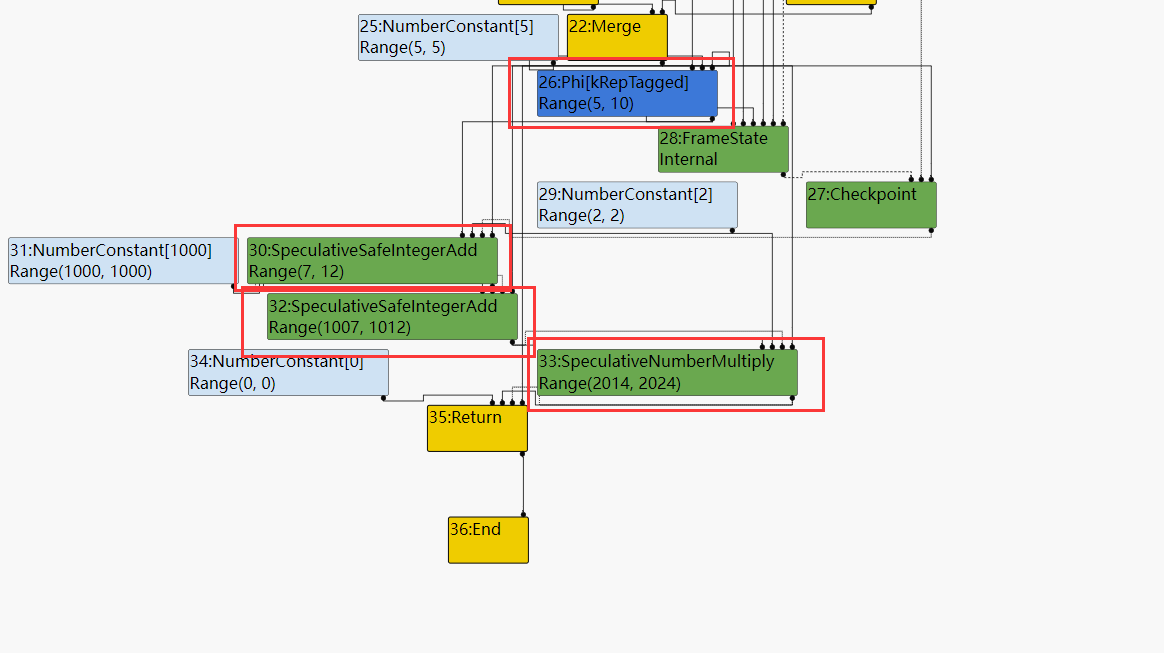
CheckBounds
之后来认识一下SoN中另一类结点CheckBounds,CheckBounds的作用是在进行load和store之前对这两个动作的索引进行检查,以防止对内存的越界读写。
下面是一个会生成CheckBounds Node的例子,左边是JS源码而右边是生成的SoN的结点
1
2
3
4
5
6
7
8
9
10
11
12
13
14
15
function opt_me(b) {
let values = [42,1337]; // HeapConstant <FixedArray[2]>
let x = 10; // NumberConstant[10] | Range(10,10)
if (b == "foo")
x = 5; // NumberConstant[5] | Range(5,5)
// Phi | Range(5,10)
let y = x + 2; // SpeculativeSafeIntegerAdd | Range(7,12)
y = y + 1000; // SpeculativeSafeIntegerAdd | Range(1007,1012)
y = y * 2; // SpeculativeNumberMultiply | Range(2014,2024)
y = y & 10; // SpeculativeNumberBitwiseAnd | Range(0,10)
y = y / 3; // SpeculativeNumberDivide | PlainNumber[r][s][t]
y = y & 1; // SpeculativeNumberBitwiseAnd | Range(0,1)
return values[y]; // CheckBounds | Range(0,1)
}
最后的Array getter在进入turbofan进行优化时将会生成一个CheckBounds Node,用于检查访问数组索引是否越界。在turbolizer打印出的SoN中也可以看到这一点:
- CheckBounds的第一个输入是访问数组使用的索引,也就是即将被check的值。
- CheckBounds的第二个输入是数组的长度,也就是check时使用的上界。
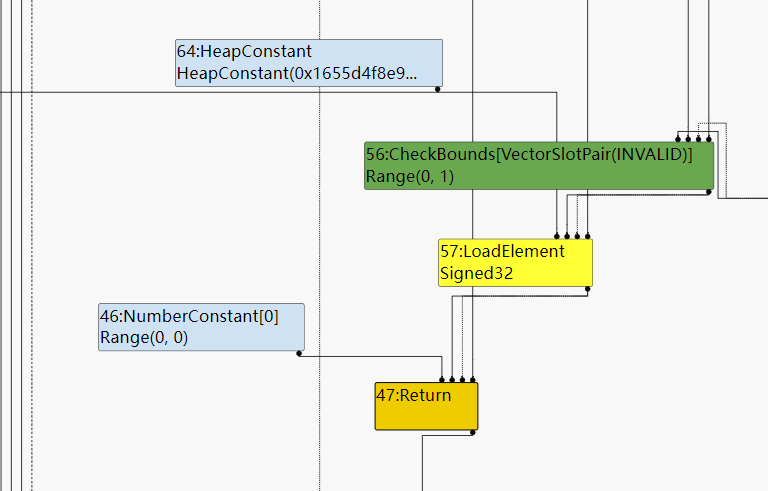
在图中可以看到CheckBound Node的Type是Range(0,1),而这个Type是在TypeCheckBound()函数中生成,我们来具体研究一下这个函数的源码:
1
2
3
4
5
6
7
8
9
10
11
12
13
14
Type Typer::Visitor::TypeCheckBounds(Node* node) {
Type index = Operand(node, 0);
Type length = Operand(node, 1);
DCHECK(length.Is(Type::Unsigned31()));
if (index.Maybe(Type::MinusZero())) {
index = Type::Union(index, typer_->cache_.kSingletonZero, zone());
}
index = Type::Intersect(index, Type::Integral32(), zone());
if (index.IsNone() || length.IsNone()) return Type::None();
double min = std::max(index.Min(), 0.0);
double max = std::min(index.Max(), length.Max() - 1);
if (max < min) return Type::None();
return Type::Range(min, max, zone());
}
- 首先从函数可以给我们的提示是CheckBounds的第一个操作数是要被检查的index Node,而第二个操作数是即将被访问的数组的length Node,首先取出这两个结点的Type。
- 在上面的例子中index为y而y在访问之前和1做与运算,所以它的Type是Range(0,1)。
- 而数组的length本来是从数组的object中load出来,但是经过load elimination之后变成一个常数constant 2。
- 然后处理了一些极端的情况:negative zero,NaN……
- 然后开始计算CheckBounds的Type,我在没有仔细看源码之前以为CheckBounds的Range就是(0, length)。但实际上不是这样:
- CheckBounds的Range的最小值是0和Index Range最小值中更大的那一个。
- 而CheckBounds的Range的最大值是length和Index Range最大值中更小的那一个。
这个时候从利用的思路来考虑如果能在Turbofan优化之后将对于数组访问的这些CheckBounds优化掉,那么没有了CheckBounds的限制我们就可以随意对数组进行访问,甚至对数组进行越界读写。而turbofan还真的提供了这样的优化。
Simplified Lowering
在simpilfied lowering中将对冗余的CheckBounds进行消除,这个优化过程将在OptimizeGraph()函数中被调用。
1
2
3
4
5
6
7
8
9
10
11
//pipeline.cc OptimizeGraph()
// Perform simplified lowering. This has to run w/o the Typer decorator,
// because we cannot compute meaningful types anyways, and the computed types
// might even conflict with the representation/truncation logic.
Run<SimplifiedLoweringPhase>();
RunPrintAndVerify(SimplifiedLoweringPhase::phase_name(), true);
// From now on it is invalid to look at types on the nodes, because the types
// on the nodes might not make sense after representation selection due to the
// way we handle truncations; if we'd want to look at types afterwards we'd
// essentially need to re-type (large portions of) the graph.
OptimizeGraph()中的Run()将调用SimpifiledLoweringPhase这个类中的Run()函数之后 的调用链:Run() -->LoweringALLNodes-->RepresentationSelector::Run()--> VisitNod()。在VisitNode中使用一个大的switch case结构根据Node的Opcode将Node分发到对应的优化函数中。
下面是对于CheckBounds类型的Node的处理过程。
1
2
3
4
5
6
7
8
9
10
11
12
13
14
15
16
17
18
19
20
21
22
23
24
25
26
27
28
case IrOpcode::kCheckBounds: {
const CheckParameters& p = CheckParametersOf(node->op());
Type index_type = TypeOf(node->InputAt(0));
Type length_type = TypeOf(node->InputAt(1));
if (index_type.Is(Type::Integral32OrMinusZero())) {
// Map -0 to 0, and the values in the [-2^31,-1] range to the
// [2^31,2^32-1] range, which will be considered out-of-bounds
// as well, because the {length_type} is limited to Unsigned31.
VisitBinop(node, UseInfo::TruncatingWord32(),
MachineRepresentation::kWord32);
if (lower() && lowering->poisoning_level_ ==
PoisoningMitigationLevel::kDontPoison) {
if (index_type.IsNone() || length_type.IsNone() ||
(index_type.Min() >= 0.0 &&
index_type.Max() < length_type.Min())) {
// The bounds check is redundant if we already know that
// the index is within the bounds of [0.0, length[.
DeferReplacement(node, node->InputAt(0));
}
}
} else {
VisitBinop(
node,
UseInfo::CheckedSigned32AsWord32(kIdentifyZeros, p.feedback()),
UseInfo::TruncatingWord32(), MachineRepresentation::kWord32);
}
return;
}
其中这个VisitiBinop()这个函数不知道是干什么的。
但是这部分的逻辑已经很清楚了,它比较CheckBounds所检查的index Node的Range Type的最小值是不是大于0.0,然后检查最大值是不是小于length Node的Range Type的最小值,如果这两个部分都成立那么说明这次范围使用的index一定不会越界,那么这次的CheckBouds是冗余的直接将它删除。(在代码中是CheckBounds的第一个操作数也就是index Node直接替代CheckBounds)。
消除完之后SoN变成下面的样子:
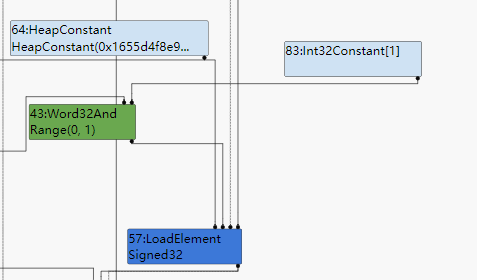
LoadElement已经直接使用Index作为操作数,看不到CheckBounds了。
Multiple Add Operation
之后再来了解一下turbofan中生成的各种加法Node,从这些Node的生成中也可以更加了解turbofan的推测优化以及,turbofan是如何对SoN中的Node进行化简。
SpeculativeSafeIntegerAdd
1
2
3
4
5
6
7
8
let opt_me = (x) => {
return x + 1;
}
for (var i = 0; i < 0x10000; ++i)
opt_me(i);
%DebugPrint(opt_me);
%SystemBreak();
在上面的例子中x + 1这个加法表达式会在bytecode graph builder阶段生成SpeculativeSafeIntegerAdd Node。
- 因为
opt_me()在之前多次执行过程中向x传入的参数都是smi,导致加法的左操作数始终为smi类型。 - 加法的右操作数为1,所以右操作数也始终是smi类型。
- 而多次循环的计算结果也是smi。
上面的三个条件导致,在bytecode运行阶段由Ignition收集到的信息是这个加法所涉及的类型只有smi:

当这个函数进入turbofan优化时生成的是SpeculativeSafeIntegerAdd这个Node,之所以是Speculative的是因为这个Node的类型是由推测得到的。
下面是在Ignition中对AddSmi进行解释执行的handler:
1
2
3
4
5
6
// AddSmi <imm>
//
// Adds an immediate value <imm> to the value in the accumulator.
IGNITION_HANDLER(AddSmi, InterpreterBinaryOpAssembler) {
BinaryOpSmiWithFeedback(&BinaryOpAssembler::Generate_AddWithFeedback);
}
从上面的handler的名字看出来AddSmi在执行的过程中也会收集feedback information。这也是为什么这样的优化被称为是推测优化,因为优化的整个过程是根据收集的feedback information做出假设进而然后针对假设的情况进行优化,一旦在执行的过程中传入不一样的操作数导致假设被推翻,将会触发deoptimization。
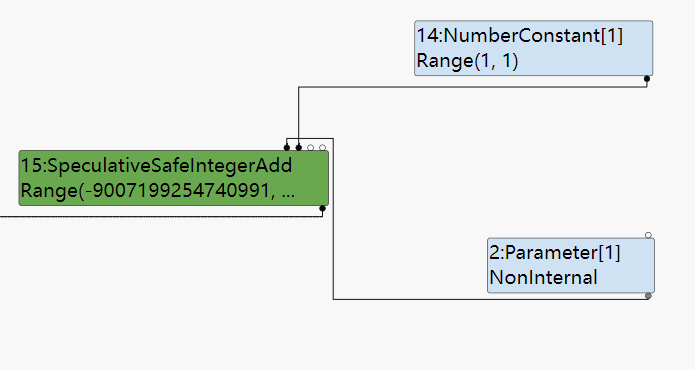
SpeculativeNumberAdd
SpeculativeNumberAdd这样的Node,可以在对下面程序的优化过程中出现。因为在opt_me()的加法表达式中右操作数的大小不在smi的范围内,导致生成的结点从上面的SpeculativeSafeIntegerAdd变成了SpeculativeNumberAdd(类型的变化是在一个lattice上前进)。
1
2
3
4
5
6
let opt_me = (x) => {
return x + 1000000000000;
}
opt_me(42);
%OptimizeFunctionOnNextCall(opt_me);
opt_me(4242);
在Ingition中的feedback也看的很清楚:

最终生成的turbofan也看的很清楚:
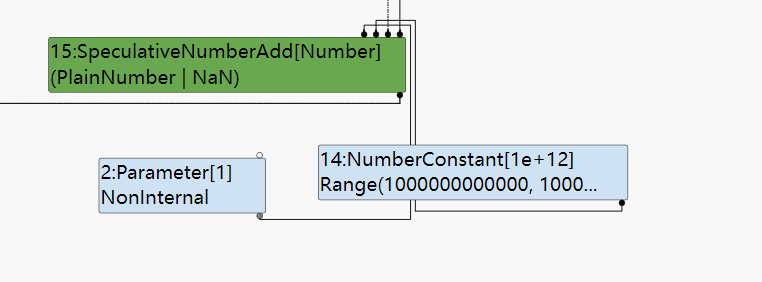
NumberAdd
1
2
3
4
5
6
7
8
9
let opt_me = (x) => {
let y = x ? 10 : 20;
return y + 100;
}
opt_me(true);
%DebugPrint(opt_me);
%OptimizeFunctionOnNextCall(opt_me);
opt_me(false);
上面这段代码中的opt_me()函数中的加法表达式在GraphBuild阶段按预期将会生成SpeculativeNumberAdd的Node来表示加法,但是当进入了typed lowering之后,turbofan会根据Node已经拥有的Type对一些Node进行化简。对于上面的例子来说:当turbofan意识到左操作数y的Type是Number类型且右操作数的类型是一个常数,这个时候可以很清楚的知道Node的类型一定是一个Number,而不需要进行任何推断,turbofan会将SpeculativeNumberAdd Node使用NumberAdd Node进行替换。
typer阶段的SoN:
![image-20220530121515476]()
typed lowering阶段的SoN:
![image-20220530121335860]()
Int32Add
1
2
3
4
5
6
7
let opt_me= (x) => {
let y = x ? 10 : 20;
return y + 100;
}
opt_me(true);
%OptimizeFunctionOnNextCall(opt_me);
opt_me(false);
和之前的例子一样opt_me()中的加法表达式在GraphBuild阶段应该生成SpeculativeSafeIntegerAdd Node,之后经历Typer、Typed Lowering(不知道为啥在Typed Lowering中没有把SpeculativeSafeIntegerAdd中的Speculative去掉?)、loop peeling……等等一系列的优化phase之后,会来到smplified lowering在这个phase中对已经经过优化的SoN中的结点再次进行Lowering。
在这个阶段中会进行TruncationPropagation(截断传播),对整个SoN进行数据流分析:为每个Node截断为合适的长度,并将截断信息进行传播。因为在上面的例子保证了SpeculativeSafeIntegerAdd 的操作数和结果都为smi,所以完全可以将这个结点截断到word32(32位),并用更简单的Node来替换这个高级的Node。所以在经历了smplified lowering之后SpeculativeSafeIntegerAdd 会变成 Int32Add。
simplified lowering之前:
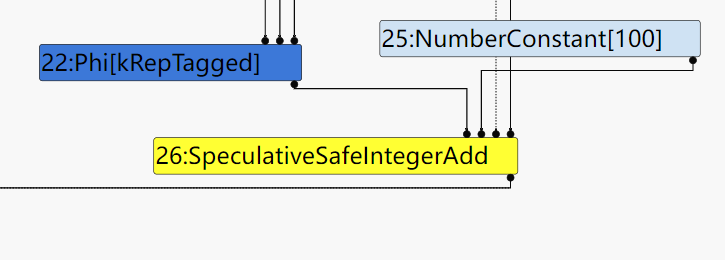
simplified lowering之后:
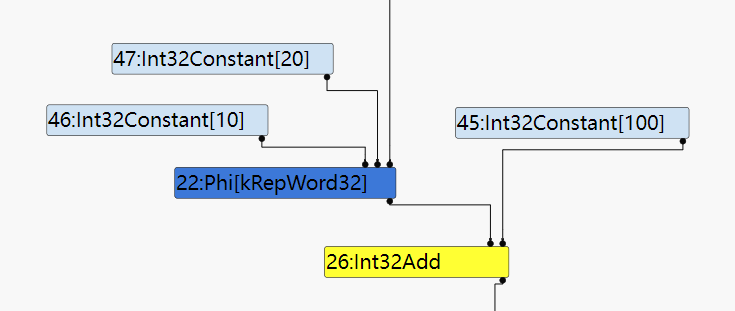
看到不但add的结点被替换掉了,而且Phi Node上也被传播上了截断信息。
JSAdd
1
2
3
4
5
6
7
8
9
10
11
let opt_me = (x) => {
let y = x ?
({valueOf() { return 10; }})
:
({[Symbol.toPrimitive]() { return 20; }});
return y + 1;
}
opt_me(true);
%OptimizeFunctionOnNextCall(opt_me);
opt_me(false);
在上面的例子中因为y是一个复杂的object所以turbofan生成一个JS层次的Node用来处理这种复杂的情况。
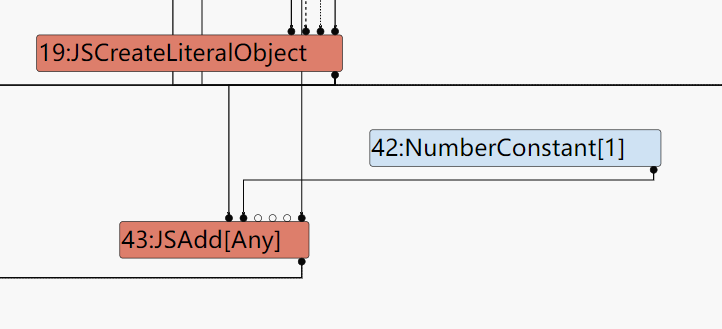
总结
到这里有关turbofan的介绍就告一段落。
这一部分是对turbofan的一些介绍,使用几个例子介绍了turbofan的优化过程。 首先对turbofan使用的IR SoN的特点以及生成SoN的意义做一下介绍。然后介绍Turbofan的Typer,介绍Turbofan是怎么样根据结点类型为每个Node打上Type。然后是Typed Lowering,观察turbofan怎么对拥有Type的Node进行化简。
之后是一些零散的知识,有关Range Type,以及CheckBounds。turbofan如何在Simpified Lowering阶段进行CheckBounds的消除。然后是对各种Add Node的介绍。

